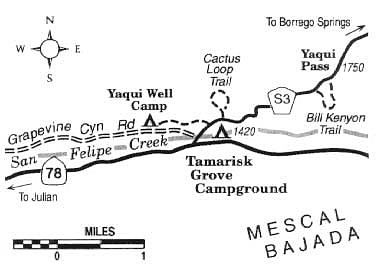 Facebook
Facebook
 X
X
 Instagram
Instagram
 TikTok
TikTok
 Youtube
Youtube
Throughout the Anza-Borrego Desert, the expandable tissues of native barrel, beavertail, cholla, fishhook, and hedgehog cacti may soon become as bloated as they ever get. Flush with supplies of water they can hoard for months on end, these plants will soon put their utmost efforts into urgent matters of reproduction. By March, cactus flowers should help suffuse the desert with a sweet, not-quite-describable orgiastic scent.
With continued rainfall, tourists could be out in droves sniffing the desert flowers, littering the roadsides with parked vehicles. But in at least one area -- Yaqui Pass -- there's lots of parking space, and plenty of room to roam over the rocky hills.
Yaqui Pass lies along County Highway S-3, 11 miles south of Borrego Springs. From the large parking lot there, which doubles as an overflow camping area, the Bill Kenyon Trail loops around the windswept, rocky, cactus-studded slopes to the east. In a couple of spots along the trail there's a near-aerial view of Mescal Bajada, a vast, sloping sheet of alluvial deposits to the south.
South of the pass, near Tamarisk Grove Campground, two other desert trails invite your exploration: the Yaqui Well Trail and Cactus Trail. On the latter you can make your acquaintance with the Bigelow, or teddy-bear cholla cactus. Although its bristles may look soft and cuddly from a fair distance, one botanical expert has made a distinctly more accurate assessment in the form of this statement: "The vegetable kingdom has not produced anything else so fearfully armed." By removing (very carefully) the straw-covered, papery sheath that coats each spine, you will discover how thin and wickedly sharp each spine tip really is.
The three short trails mentioned above are just a starting point for exploring this, or any other part of Anza-Borrego. To really get to know the place -- and avoid most other visitors at the same time -- just start walking in any direction. The number of people out and about in the desert wilderness declines with the square of the distance and with the cube of the elevation gain from the nearest road.


Throughout the Anza-Borrego Desert, the expandable tissues of native barrel, beavertail, cholla, fishhook, and hedgehog cacti may soon become as bloated as they ever get. Flush with supplies of water they can hoard for months on end, these plants will soon put their utmost efforts into urgent matters of reproduction. By March, cactus flowers should help suffuse the desert with a sweet, not-quite-describable orgiastic scent.
With continued rainfall, tourists could be out in droves sniffing the desert flowers, littering the roadsides with parked vehicles. But in at least one area -- Yaqui Pass -- there's lots of parking space, and plenty of room to roam over the rocky hills.
Yaqui Pass lies along County Highway S-3, 11 miles south of Borrego Springs. From the large parking lot there, which doubles as an overflow camping area, the Bill Kenyon Trail loops around the windswept, rocky, cactus-studded slopes to the east. In a couple of spots along the trail there's a near-aerial view of Mescal Bajada, a vast, sloping sheet of alluvial deposits to the south.
South of the pass, near Tamarisk Grove Campground, two other desert trails invite your exploration: the Yaqui Well Trail and Cactus Trail. On the latter you can make your acquaintance with the Bigelow, or teddy-bear cholla cactus. Although its bristles may look soft and cuddly from a fair distance, one botanical expert has made a distinctly more accurate assessment in the form of this statement: "The vegetable kingdom has not produced anything else so fearfully armed." By removing (very carefully) the straw-covered, papery sheath that coats each spine, you will discover how thin and wickedly sharp each spine tip really is.
The three short trails mentioned above are just a starting point for exploring this, or any other part of Anza-Borrego. To really get to know the place -- and avoid most other visitors at the same time -- just start walking in any direction. The number of people out and about in the desert wilderness declines with the square of the distance and with the cube of the elevation gain from the nearest road.
